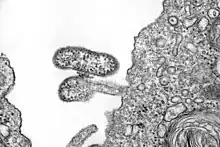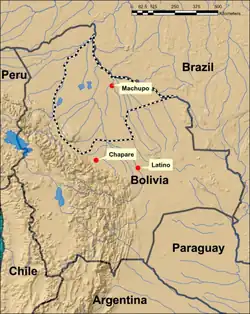Chapare mammarenavirus
| Chapare mammarenavirus | |
|---|---|
 | |
| electron microscope image of Chapare virus | |
| Virus classification | |
| (unranked): | Virus |
| Realm: | Riboviria |
| Kingdom: | Orthornavirae |
| Phylum: | Negarnaviricota |
| Class: | Ellioviricetes |
| Order: | Bunyavirales |
| Family: | Arenaviridae |
| Genus: | Mammarenavirus |
| Species: | Chapare mammarenavirus |
| Synonyms[1] | |
|
Chapare virus | |
| Chapare hemorrhagic fever | |
|---|---|
| Specialty | Virology |
Chapare mammarenavirus or Chapare virus is a virus from the family Arenaviridae which causes a hemorrhagic fever in humans known as Chapare hemorrhagic fever. It was first described after an outbreak of a novel zoonotic mammarenavirus infection occurred in the village of Samuzabeti, Chapare Province, Bolivia, in January 2003. A small number of people were infected and one person died.[2][3][4]
Virology
The Chapare virus is an enveloped virus with a bi-segmented single-stranded ambisense RNA genome. The two RNA segments are denoted Small (S) and Large (L). It belongs to the New World Clade B lineage of mammarenaviruses and is most closely related to the Sabia virus.[2][5]
Disease
Symptoms
After an incubation period of around 9–19 days, initial symptoms include fever, malaise, headache, myalgia, back pain, dizziness, nausea, vomiting and diarrhoea. The disease often progresses to include hemorrhagic and neurological symptoms, such as gingival hemorrhage, anaemia, leukopaenia, confusion, seizures, echymoses, bleeding from mucous membranes, hemorrhagic shock and multi-organ failure.[2][5]
Chapare virus RNA was detected in the blood, urine, conjunctiva, semen and in broncho-alveolar and nasopharyngeal samples of the infected patients. Those who survived often had prolonged residual neurological symptoms. Viral RNA was detected in survivors up to 170 days after infection and infectious Chapare virus was obtained in a semen sample of one patient 86 days after symptom onset.[5]
Treatment
Treatment relies mostly on supportive care and early diagnosis. Specific antiviral therapy for Chapare virus infection has yet to be properly investigated.[5]
Epidemiology

In 2019, nine people became infected with the virus in the La Paz regional area, four of whom died. Nosocomial and human-to-human transmission of the virus occurred in at least three of the cases which resulted in the death of a medical intern and a gastroenterologist. Like other members of the Arenavirus family, the specific zoonotic reservoir and primary transmission vector is suspected to be a rodent, probably the small-eared pygmy rice rat.[5][6][2]
References
- ↑ Buchmeier, Michael J.; et al. (2 July 2014). "Rename one (1) genus and twenty-five (25) species in the family Arenaviridae" (PDF). International Committee on Taxonomy of Viruses (ICTV). Archived (PDF) from the original on 25 September 2022. Retrieved 14 June 2019.
in the family Arenaviridae change the name of genus Arenavirus to Mammarenavirus and convert the names of its constituent species to a binomial format, by appending the name Mammarenavirus to each existing name
- 1 2 3 4 Delgado S, Erickson BR, Agudo R, Blair PJ, Vallejo E, Albariño CG, Vargas J, Comer JA, Rollin PE, Ksiazek TG, Olson JG, Nichol ST (April 2008). "Chapare virus, a newly discovered arenavirus isolated from a fatal hemorrhagic fever case in Bolivia". PLOS Pathog. 4 (4): e1000047. doi:10.1371/journal.ppat.1000047. PMC 2277458. PMID 18421377.
- ↑ "New kind of killer virus discovered in Bolivia". NewScientist. New Scientist. Archived from the original on 2012-10-18. Retrieved 2008-04-17.
- ↑ "Evidence shows human transmission in deadly outbreak of mysterious disease in Bolivia". EurekAlert!. The American Society of Tropical Medicine and Hygiene. 16 November 2020. Archived from the original on 16 November 2020. Retrieved 17 November 2020.
- 1 2 3 4 5 Mafayle RL, Morales-Betoulle ME, Romero C, Cossaboom CM, Whitmer S, Aguilera CE, Ardaya CA, Zambrana MC, Anajia AD, Loayza NM, Montano AM, Alvis FL, Guzman JR, Martinez SS, De La Vega GA, Ramirez AM, Gutierrez JT, Pinto AJ, Bacci RS, Brignone J, Garcia J, Anez A, Mendez-Rico J, Luz K, Segales A, Cruz KM, Valdivia-Cayoja A, Amman BR, Choi MJ, Erickson BR, Goldsmith C, Graziano JC, Joyce A, Klena JD, Leach A, Malenfant JH, Nichol ST, Patel K, Sealy T, Shoemaker T, Spiropoulou CF, Todres A, Towner JS, Montgomery JM (June 2022). "Chapare hemorrhagic fever and virus detection in rodents in Bolivia in 2019". New England Journal of Medicine. 386 (24): 2283–2294. doi:10.1056/NEJMoa2110339. Archived from the original on 20 June 2022. Retrieved 20 June 2022.
- ↑ "Researchers confirm human-to-human transmission of rare virus in Bolivia". the Guardian. 2020-11-16. Archived from the original on 2020-11-17. Retrieved 2020-11-17.
External links
| Classification |
|---|